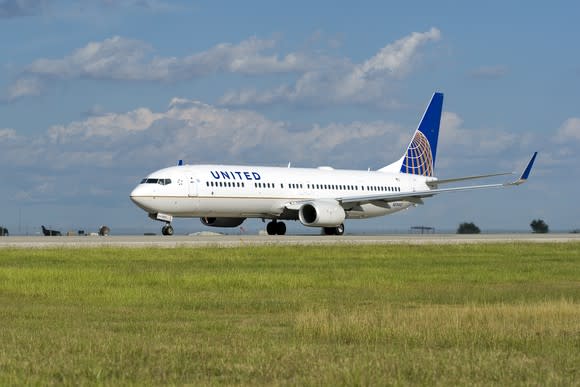Don't Blame Spirit Airlines for Low Airfares
Oil prices have increased significantly from their lows of early 2016. Nevertheless, air travelers in the U.S. are still benefiting from surprisingly low ticket prices. In the third quarter of 2017 -- the most recent period for which official statistics are available -- the average domestic airfare was $335.83, down from $396.37 three years earlier.
American Airlines (NASDAQ: AAL) CEO Doug Parker told analysts on the company's recent earnings call that fares are too low given the price of oil. Some pundits are blaming fast-growing budget carrier Spirit Airlines (NYSE: SAVE) for the depressed fare environment. However, the growing battle for connecting traffic between American Airlines and United Continental (NYSE: UAL) has been a much bigger contributor to the recent fare weakness.
United Airlines is supplying the most growth
Earlier this week, Spirit Airlines stated that it plans to expand capacity by about 23% this year. That would be significantly faster than its 16.1% capacity growth in 2017.

Spirit Airlines is planning for capacity growth of about 23% this year. Image source: Spirit Airlines.
Twenty-three percent certainly sounds like a big number, so it might seem natural to attribute the ongoing fare wars to Spirit's growth. However, Spirit Airlines remains quite small compared with most of its rivals. In fact, United Continental's plan to increase its capacity 4%-6% this year (and even faster in the domestic market) is having a bigger impact on the supply demand balance.
In the first quarter of 2017, United's domestic capacity totaled 32.5 million available seat miles (ASMs). By contrast, Spirit's total capacity, which includes some flights to the Caribbean and Latin America, came in at 6.9 million ASMs during the same period.
Looking at Spirit's Q1 2018 guidance, it appears that the carrier will increase its capacity by about 1.5 million ASMs. Meanwhile, United's domestic ASMs will increase by about 2 million, with additional growth outside the United States. Thus, on an absolute basis, 5% growth at United adds more incremental capacity than 20%-25% growth at Spirit Airlines.

United Airlines will add more capacity in the U.S. than Spirit Airlines in 2018. Image source: United Airlines.
Spirit Airlines' growth isn't very disruptive
The number of seats being added to the market isn't the only factor that affects pricing. It also matters where the extra capacity is being deployed.
Spirit Airlines has been focusing much of its capacity growth on midsize cities recently. It's adding flights in places like Hartford, Connecticut; Pittsburgh, Pennsylvania; Richmond, Virginia; and Columbus, Ohio -- primarily serving leisure destinations such as Orlando, Fort Lauderdale, and Las Vegas.
These routes are ideal for Spirit Airlines because it's usually easy to stimulate leisure travel demand by offering low fares. Furthermore, the carrier doesn't compete directly with the likes of United Airlines and American Airlines on most of its new routes.
Indeed, Spirit's management hasn't highlighted any of these cities as causes of its recent unit revenue declines. Instead, most of the trouble is coming from big hub markets like Chicago, Dallas, and Houston, where Spirit Airlines is growing very little -- or not at all.
The legacy carriers are fighting for volume
It's not a coincidence that Spirit is seeing the most pricing pressure in these legacy carrier hub markets. (United Airlines has hubs in Chicago and Houston, while American Airlines has hubs in Chicago and Dallas.) United and American are in the midst of a winner-take-all fight to create the best connecting hubs in the mid-continent region.
As top executives at both airline giants have emphasized recently, scale has a big impact on hub profitability. By operating more flights at a given hub, an airline can enable a greater number of potential connecting itineraries, thereby capturing more high-yield connecting traffic from smaller cities. Driving more volume through each hub also allows legacy carriers to upgauge to larger airplanes that have lower unit costs.
The net result is that United Airlines and American Airlines are battling for market share. Both carriers hope to increase their margins by boosting traffic at their connecting hubs.
Instead, consumers are benefiting from the workings of the "invisible hand." The quest by two of the three largest U.S. airlines to drive ever more volume through the same number of hubs is pushing fares down, with little tangible benefit to either carrier. Spirit Airlines isn't the main cause of the current low-fare environment -- it's more like collateral damage.
More From The Motley Fool
Adam Levine-Weinberg owns shares of Spirit Airlines. The Motley Fool owns shares of and recommends Spirit Airlines. The Motley Fool has a disclosure policy.

 Yahoo Finance
Yahoo Finance 